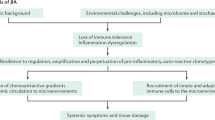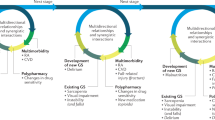Abstract
Pain in children with rheumatic disease is common, and is most often caused by arthritis. Despite the widespread use of effective new biologic agents, pain continues to be a problem in these patients, and it greatly impairs their daily functioning and quality of life. The pathogenesis of pain in children with rheumatic diseases is multifactorial, and disease treatment alone is often not enough to alleviate it. No standard of care or detailed algorithm for managing pain in these patients exists. Specific pain treatments often include acetaminophen, NSAIDs and medications that treat arthritis, such as methotrexate and etanercept. Other approaches should include nonpharmacologic interventions, for example exercise and cognitive-behavioral therapy, as well as the use of analgesics such as opioids in patients whose pain is refractory to standard therapies. The use of systemic corticosteroids to treat pain in children with arthritis should be avoided.
Key Points
-
Pain continues to be common in children with rheumatic diseases, despite advances in arthritis treatment
-
The pathogenesis of pain in children with rheumatic diseases is multifactorial
-
Pain management should be interdisciplinary and consist of nonpharmacologic as well as pharmacologic interventions
-
There are no current detailed treatment guidelines for treatment of pain in children with rheumatic diseases
-
More agressive pain treatments should be considered in those patients who continue to have significant residual pain
This is a preview of subscription content, access via your institution
Access options
Subscribe to this journal
Receive 12 print issues and online access
$209.00 per year
only $17.42 per issue
Buy this article
- Purchase on Springer Link
- Instant access to full article PDF
Prices may be subject to local taxes which are calculated during checkout
Similar content being viewed by others
References
Lovell D and Walco GA (1989) Pain associated with juvenile rheumatoid arthritis. Pediatr Clin North Am 36: 1015–1027
Petty RE et al. (2004) International League of Associations for Rheumatology classification of juvenile idiopathic arthritis: second revision, Edmonton, 2001. J Rheumatol 31: 390–392
Sherry D et al. (1990) Painless juvenile rheumatoid arthritis. J Pediatr 116: 921–923
Schanberg L et al. (1997) Pain coping and the pain experience in children with juvenile chronic arthritis. Pain 73: 181–189
Hagglund K et al. (1995) Predicting pain among children with juvenile rheumatoid arthritis. Arthritis Care Res 8: 36–42
Schanberg L et al. (2003) Daily pain and symptoms in children with polyarticular arthritis. Arthritis Rheum 48: 1390–1397
Dhanani S et al. (2002) Minimal difference in pain associated with change in quality of life in children with rheumatic disease. Arthritis Rheum 47: 501–505
Gruver D (2004) Living with rheumatoid arthritis: unmet needs [http://www.arthritis.org/conditions/diseasecenter/RA/RASurvey/ WhitePaperFinal.pdf] (accessed 9 February 2007)
Merkel S et al. (1997) The FLACC: a behavioral scale for scoring postoperative pain in young children. Pediatr Nursing 23: 293–297
Kidd BL and Urban LA (2001) Mechanisms of inflammatory pain. Br J Anaesth 87: 3–11
Giordano J (2006) The neuroscience of pain and analgesia. In Weiner's Pain Management: A Practical Guide for Clinicians (Eds Boswell MV and Cole BE) Boca Raton: Taylor & Francis
Zeltzer L et al. (1997) Pain responsiveness and chronic pain: a psychobiological perspective. J Develop Behav Pediatr 18: 13–22
Woolf CJ and Salter MW (2000) Neuronal plasticity: increasing the gain in pain. Science 288: 1965–1969
Pediatric chronic pain: a position statement from the American Pain Society [http://www.ampainsoc.org/advocacy/pediatric.htm] (accessed 9 February 2007)
Thompson K et al. (1987) Comprehensive assessment of pain in juvenile rheumatoid arthritis: an empirical model. J Pediatr Psychol 12: 241–255
Ilowite N et al. (1992) Assessment of pain in patients with juvenile rheumatoid arthritis: relation between pain intensity and degree of joint inflammation. Ann Rheum Dis 51: 343–346
Malleson P et al. (2004) Predictors of pain in children with established juvenile rheumatoid arthritis. Arthritis Rheum 51: 222–227
Rapoff MA and Lindsley CB (2000) The pain puzzle: a visual and conceptual metaphor for understanding and treating pain in pediatric rheumatic disease. J Rheumatol Suppl 58: 29–33
Zeltzer L et al. (1997) A psychobiologic approach to pediatric pain: Part II. Prevention and treatment. Curr Prob Pediatr 27: 264–284
Anonymous (2002) Guideline for the management of pain in osteoarthritis, rheumatoid arthritis and juvenile chronic arthritis. Glenview: American Pain Society
Kimura Y et al. (2006) Treatment of pain in juvenile idiopathic arthritis: a survey of pediatric rheumatologists. Arthritis Rheum 55: 81–85
Hashkes PJ and Laxer RM (2005) Medical treatment of juvenile idiopathic arthritis. JAMA 294: 1671–1684
Weiss J and Ilowite NT (2005) Juvenile idiopathic arthritis. Pediatr Clin North Am 52: 413–442
Lang B and Finlayson LA (1994) Naproxen-induced pseudoporphyria in patients with juvenile rheumatoid arthritis. J Pediatr 124: 639–642
Dominick K et al. (2004) Patterns of opioid analgesic prescription among patients with osteoarthritis. J Pain Palliat Care Pharmacother 18: 31–46
Kalso E et al. (2004) Opioids in chronic non-cancer pain: systematic review of efficacy and safety. Pain 112: 372–380
Cowan D et al. (2005) A randomized, double-blind, placebo-controlled, cross-over pilot study to assess the effects of long-term opioid drug consumption and subsequent abstinence in chronic noncancer pain patients receiving controlled-release morphine. Pain Med 6: 113–121
Caldwell J et al. (1999) Treatment of osteoarthritis pain with controlled release oxycodone or fixed combination oxycodone plus acetaminophen added to nonsteroidal antiinflammatory drugs: a double blind, randomized, multicenter, placebo controlled trial. J Rheumatol 26: 862–869
Furlan AD et al. (2006) Opioids for chronic noncancer pain: a meta-analysis of effectiveness and side effects. CMAJ 174: 1589–1594
Malonne H et al. (2004) Efficacy and tolerability of sustained-release tramadol in the treatment of symptomatic osteoarthritis of the hip or knee: a multicenter, randomized, double-blind, placebo-controlled study. Clin Ther 26: 1774–1782
Walker JS (2003) Anti-inflammatory effects of opioids. Adv Exp Med Biol 521: 148–160
Varni JW et al. (1990) Cognitive-behavioral assessment and treatment of pediatric pain. In Handbook of Clinical Behavioral Pediatrics, 83–97 (eds Gross AM and Drabman RS) New York: Plenum Press
Eccelston C et al. (2002) Systematic review of randomised controlled trials of psychological therapy for chronic pain in children and adolescents, with a subset meta-analysis of pain relief. Pain 99: 157–165
Walco G et al. (1999) Empirically supported treatments in pediatric psychology: disease related pain. J Pediatr Psychol 24: 155–167
Lavigne J et al. (1992) Evaluation of a psychological treatment package for treating pain in juvenile rheumatoid arthritis. Arthritis Care Res 5: 101–110
Walco G et al. (1992) Cognitive-behavioral pain management in children with juvenile rheumatoid arthritis. Pediatrics 89: 1075–1079
Takken T et al. (2003) Relationship between functional ability and physical fitness in juvenile idiopathic arthritis patients. Scand J Rheumatol 32: 174–178
Takken T et al. (2002) Aerobic fitness in children with juvenile idiopathic arthritis: a systematic review. J Rheumatol 29: 2643–2637
Klepper S (1999) Effects of an eight-week physical conditioning program on disease signs and symptoms in children with chronic arthritis. Arthritis Care Res 12: 52–60
Singh-Grewal D et al. (2006) Pilot study of fitness training and exercise testing in polyarticular childhood arthritis. Arthritis Rheum 55: 364–372
Maenpaa H et al. (2003) Elbow synovectomy on patients with juvenile rheumatoid arthritis. Clin Orthop Rel Res 412: 65–70
Iesaka K et al. (2006) Orthopedic surgical management of hip and knee involvement in patients with juvenile rheumatoid arthritis. Am J Orthop 35: 67–73
Kitsoulis P et al. (2006) Total hip arthroplasty in children with juvenile chronic arthritis: long-term results. J Pediatr Orthop 26: 8–12
Palmer D et al. (2005) Total knee arthroplasty in juvenile rheumatoid arthritis. J Bone Joint Surg Am 87: 1510–1514
van der Heijde D et al. (2006) Comparison of etanercept and methotrexate, alone and combined, in the treatment of rheumatoid arthritis: two-year clinical and radiographic results from the TEMPO study: a double-blind, randomized trial. Arthritis Rheum 54: 1063–1074
Field T et al. (1997) Juvenile rheumatoid arthritis: benefits from massage therapy. J Pediatr Psych 22: 607–617
Powell M et al. (2005) Efficacy of custom foot orthotics in improving pain and functional status in children with juvenile idiopathic arthritis: a randomized trial. J Rheumatol 32: 943–950
Gossec L et al. (2006) Nonpharmacological treatments in early rheumatoid arthritis: clinical practice guidelines based on published evidence and expert opinion. Joint Bone Spine 73: 396–402
Weiss JE et al. (2006) Analgesia for intra-articular corticosteroid injections in juvenile idiopathic arthritis (JIA): a survey of pediatric rheumatologists [abstract]. Arthritis Rheum 54 (Suppl): S171
Author information
Authors and Affiliations
Corresponding author
Ethics declarations
Competing interests
Dr. Walco is a consultant to Cephalon and Endo Pharmaceuticals, as well as an investigator in a clinical trial sponsored by Cephalon.
Dr. Kimura is an investigator in clinical trials sponsored by NIH, Amgen and Regeneron.
Rights and permissions
About this article
Cite this article
Kimura, Y., Walco, G. Treatment of chronic pain in pediatric rheumatic disease. Nat Rev Rheumatol 3, 210–218 (2007). https://doi.org/10.1038/ncprheum0458
Received:
Accepted:
Issue Date:
DOI: https://doi.org/10.1038/ncprheum0458
This article is cited by
-
Musculoskeletal pain and its effect on daily activity and behaviour in Icelandic children and youths with juvenile idiopathic arthritis: a cross-sectional case-control study
Pediatric Rheumatology (2022)
-
Feasibility of quantitative sensory testing in juvenile idiopathic arthritis
Pediatric Rheumatology (2022)
-
Identifying the content and context of pain within paediatric rheumatology healthcare professional curricula in the UK: a summative content analysis
Pediatric Rheumatology (2021)
-
The effect of repeated methotrexate injections on the quality of life of children with rheumatic diseases
European Journal of Pediatrics (2019)
-
Cognitive behavioral group intervention for pain and well-being in children with juvenile idiopathic arthritis: a study of feasibility and preliminary efficacy
Pediatric Rheumatology (2015)



